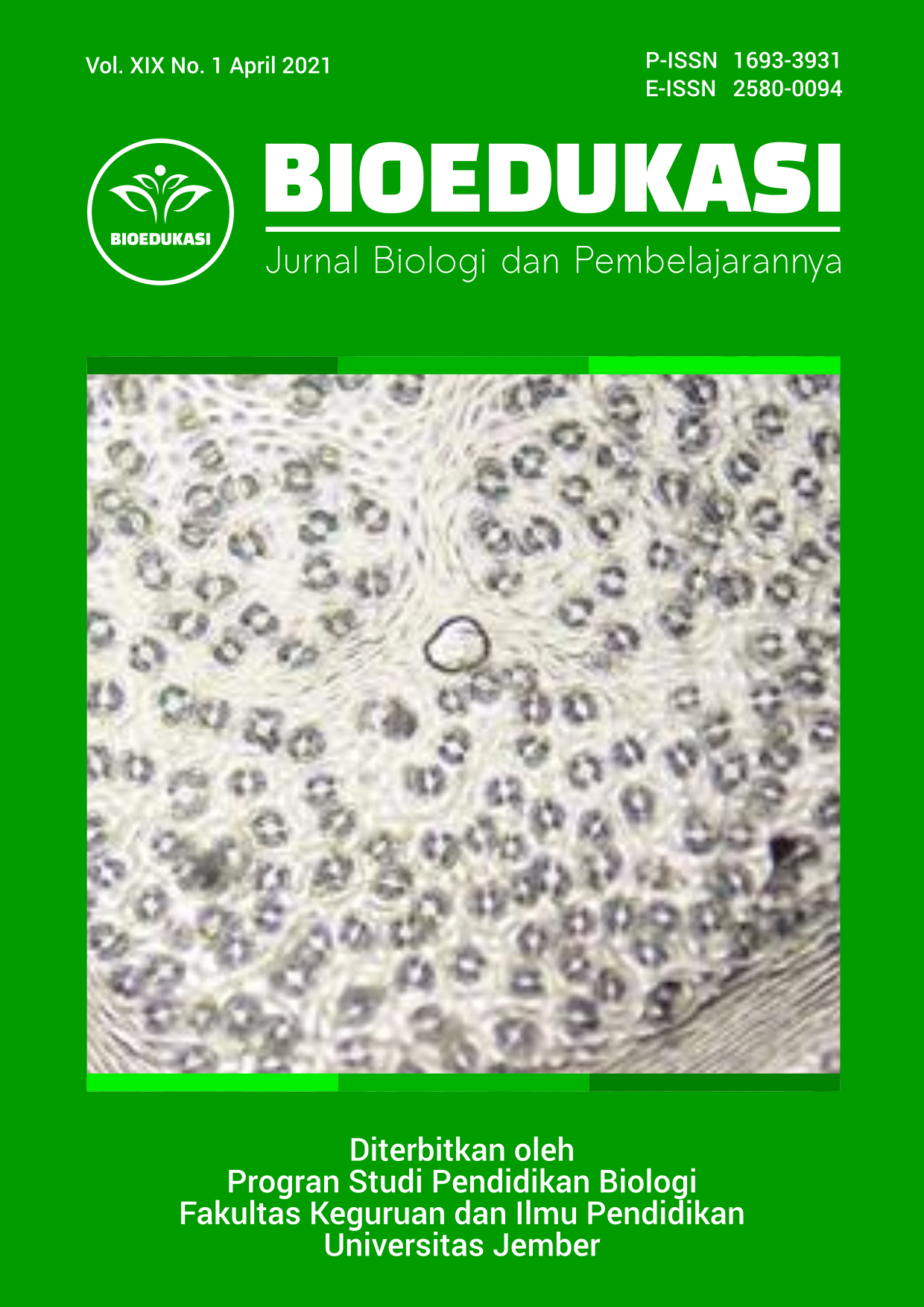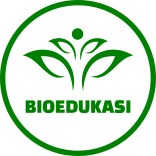POTENCY OF ANTICANCER COMPOUNDS FROM THE InaCC LIPI COLLECTION Actinomycetes WERE ANALYZED USING antiSMASH
DOI:
https://doi.org/10.19184/bioedu.v19i1.22747Keywords:
anticancer compounds; Actinomycetes; InaCC LIPI 2011-2016; antiSMASHAbstract
Every year cancer cases have always increased. According to WHO data, in 2020, there were 19.2 million cases of cancer. Cancer treatment is still developing by exploring medicinal compounds that have a minimal risk to healthy cells but can still kill cancer cells. Secondary metabolites from the phylum Actinomycetes are often explored to determine their usefulness, one of which is an anticancer compound. The InaCC project from LIPI has several collections of Actinomycetes that have never been explored, mainly novel species obtained in the 2011-2016 timeframe. The purpose of this study was to analyze the genomic sequences of the InaCC Actinomycetes collection using antiSMASH to determine the potential of the compounds for anticancer. First, the genome sequence data search was carried out through the NCBI gene bank, then analyzed the sequences using antiSMASH 5.0, after searching for the compounds' potential through publication search using the ChEMBL Database and Google Scholar. In the NCBI database, all bacterial phylum Actinomycetes InaCC 2011-2016 have not found any genomic sequence data to use bacteria with the closest relationship for antiSMASH analysis. The closest relatives' analysis results showed that BGC compounds that can have anticancer properties in the bacterial collection of the phylum Actinomycetes InaCC 2011-2016 include terpenes butyrolactol, furans, alkyresorcinol, desferroxamine, and siderophore. These results indicate that the phylum Actinomycetes bacteria could have BGC anticancer compounds and could be developed to treat cancer. The analysis of this research needs to be confirmed again if each bacterium's genomic sequence is complete.
Downloads
References
Buss, J. L., Torti, M. F., and Torti, S. V. 2003. The role of iron chelation in cancer therapy. Curr. Med. Chem. 10:1021-1034.
Chen, C., Ye, Y., Wang, R., Zhang, Y. Wu, C., Debnath, S.C., Ma, Z., Wang, J., and Wu, M. 2018. Streptomyces nigra sp. nov. is a novel Actionobacterium isolated from mangrove soil and exerts a potent antitumor activity in vitro. Front. Microbiol. 9:1587.
Costa, D. C. S., de Almeida, G. S., Rabelo, V. W., Cabral., L. M., Sathler, P. C., Abreau, P. A., Ferreira, V. F., da Silva, L. C. R. P., da Silva, F. C. 2018. Synthesis and evaluation of the cytotoxic activity furanapthoquinones tethered to 1H-1,2,3-triazoles in Caco2, Calu-3, MDA-MB231 cells. Eur. J. Med. Chem. 156:524-533.
Girao, M., Riberio, I., Riberio, T., Azevedo, I. C., Pereira, F., Urbatzka, R., Leao, P.N., and Carvalho, M.F. 2019. Actinobacteria isolated from Laminaria ochroleuca: a source of new bioactive compounds. Front. Microbiol. 10:683.
GLOBOCAN. 2020. Latest global cancer data in 2020. <https://gco.iarc.fr/today/data/factsheets/populations/900-world-fact-sheets.pdf>. WHO. Accesed February, 1st 2021.
Grosso, G., Bella, F., Godos., J., Sciacca, S., Del Rio, D., Ray, S., Galvano, F., and Giovannuci, E. L., 2017. Possible role of diet in cancer: systematic review and multiple meta-analyses of dietary patterns, lifestyle factors, and cancer risk. Nutr. Rev. 75(6):405-419.
Hamada, M., Shibata, C., Nurkanto, A., Ratnakomala, S., Lisdiyanti, P., Tamura, T., and Suzuki, K. 2015a. Tropicihabitans flavus gen. nov., sp., nov., a new member of the family Cellulommonadacease. A. Van. Leeuw. J. Microb. 107:1299-1306.
Hamada, M., Shibata, C., Nurkanto, A., Ratnakomala, S., Lisdiyanti, P., Tamura, T., and Suzuki, K. 2015b. Serinibacter tropicus sp. nov., an actinobacterium isolated from the rizhosphere of a mangrove, and emended description of the genus Serinibacter. Int. J. Syst. Evol. Microbiol. 65(Pt4):1151-1154.
Heap, J.T., Theys, J., Ehsaan, M., Kubiak, A.M., Dubois, L., Paesmans, K., Van Mellaert, L., Knox, R. Kuehne, S.A., Lambin, P., and Minton, N.P. 2014. Spores of Clostridium engineeried for clinical efficacy an safety cause regression an cure of tumors in vivo. Oncotarget. 5(7):1761-9.
Kruk, J., Aboul-Enein, B., Bernstein, J., and Marchlewicz M. 2017. Dietery alkylresorcinols and cancer prevention: a systematic review. Eur. Food. Res. Technol. 243:1693-1710.
Li, G., Wang, J., Li., X., Xu, J., Zhang, Z., and Si, J. 2018. A new terpene coumarin microbial transformed by Mucor polymorphosporus induces apoptosis of human gastric cancer cell line MGC-803. Arch. Pharm. Res. 41(6):646-654.
Nakaew, N., Pathom-aree, W., and Lumyong, S. 2009.Generic diversity of rare Actinomycetes from Thai Cave soils and their possible use as new bioactive compounds. Actinomycetologica. 23:21-26.
Nurkanto, A., Lisdiyanti, P., hamada, M., Ratnakomala, S., Shibata, C., and Tamura, T. 2015. Cryptosporangium cibodasense sp. nov., isolated from leaf litter in Indonesia. Int. J. Syst. Evol. Microbiol. 65(12):4632-4637.
Nurkanto, A., Lisdiyanti, P., Hamada, M., Ratanakomala, S., Shibata, C., and Tamura, T. 2016. Actinoplane bogoriensis sp. nov., a novel actinomycete isolated from leaf litter. J. Antibiot. 69(1):26-30.
Otogura, M., Yamamura, H., Tamura, T., Irzaldi, R., ratnakomala, S., Ridwan, R., Kartina, G., Triana, E., Nurkanto, A., Lestari, Y., Lisdiyanti, P., Widyastuti, Y., and Ando, K. 2011. Actinophytocola timorensis sp. nov. and Actinophytocola corallina sp. nov., isolated from soil. Int. J. Syst. Evol. Microbiol. 61(Pt4):834-838.
Ramirez-Rodriguez, L., Stepanian-Martinez, B., Morales-Gonzalez, M., and Diaz L. 2018. Optimazation of the cytotoxic activity of three Streptomyces strains isolated from Guaviare river sediments (Colombia, South America). Bio. Med. Resr. Int. ID2839356.
Ratnakomala, S., Lisdiyanti, P., and Widyastuti, Y. 2016. Collection of Indonesian Actinomycetes and its uses. LIPI Press. 177-198.
Rejinold, N, S., Baby, T., Chennazhi, K. P., and Jayakumar, R. 2015. Multi drug loaded-thermo-responsive-fibrinogen-graft-poly(N-vinyl caprolactam) nanogels for breast cancer drug delivery. J. Biomed. Nanotechnol. 11(3):392-402.
Sagar, S., Esau, L. Hikmawan, T., Antunes, A., Holtermann, K., Stingl, U. Bajic, B.V., and Kaur M. 2013. Cytotoxic and apoptotic aveluations of marine bacteria isolated from brine-seawater interface of the Red Sea. BMC. Compl. Altr. Med. 13:29-36.
Saha, P., Yeoh, B. S., Xiao, X., Golonka, R. M., Kumarasamy, S., and Vijay-Kumar, M. 2019. Enterobactin, an iron chelating, bacterial siderophore, arrests cancer cell proliferation. Bichem. Pharm. 168:71-81.
Singh, A., Masoodi, M., Nabi, N., and Ashraf, I. 2019. Medicinal plants as combating strategy against cancer: a review. UGC. J. 7(4).
Wang, L., Li, X., Mu, y., Lu, C., Tang, S., Lu, K., Qiu, X., Wei, A., Cheng, Y, and Wei, W. 2019. The iron chelator desferrioxamine synergizes with chemotherapy for cancer treatment. J. Trace. Elem. Med. Bio. 56:131-238.






